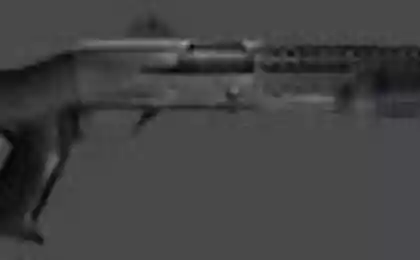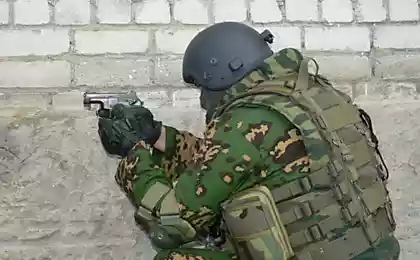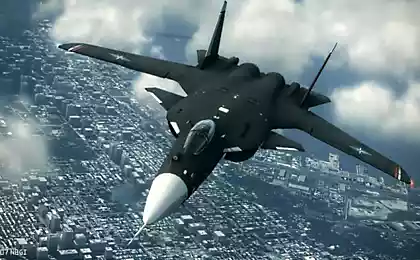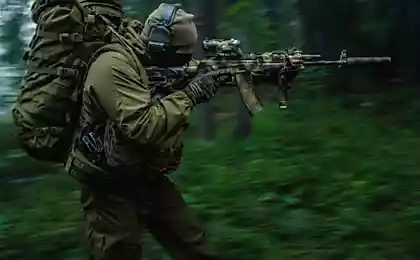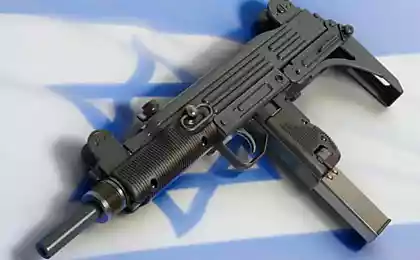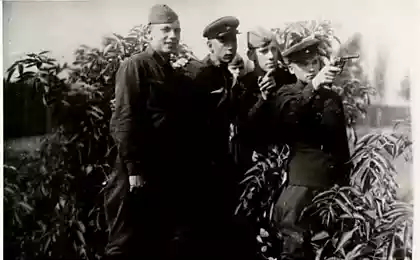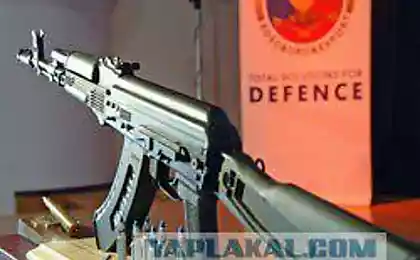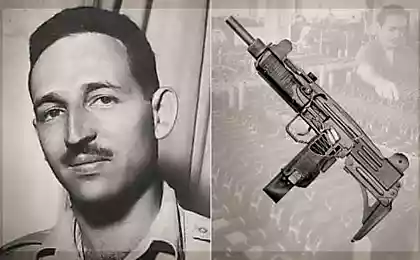1376
Copies of Kalashnikov
Sa vz. 58 (Czech Republic)
After creating in 1955 the Warsaw Treaty Organization (WTO) under the leadership of the Soviet Union, in the framework of the countries - participants, started standardization of weapon systems and ammunition.
Most countries - Soviet satellites came very simply and had adopted the Soviet AK-47 (and later AKM) in a more or less modified form. However, Czechoslovakia, which had historically very strong and advanced armaments jobs, chose to create their own designs of weapons under the overall cartridge.
Auto Sa vz. 58 are of high quality and exterior, as well as the original design. Despite the resemblance to the Soviet AK Czech machine it was fundamentally different, and completely original design. Even the machine shop model 58 was a completely different, although superficially similar to the store Kalashnikov.

LADA / CZ 2000 (Czech Republic)
In 1989, after a series of tests and improvements, the company Ceská Zbrojovka has introduced a family of small arms caliber LADA 5, 45h39 mm.
For reasons of unification of weapons, as well as economy, in contrast to the machine CZ Sa vz. 58 Czechs have decided not to develop the original system, and modify the Soviet system on the basis of Kalashnikov AK-74 at their wishes and preferences.
LADA / CZ 2000 is characterized by high service and performance characteristics, virtually conceding the Soviet AK-74 assault rifles and American M16A2 reliability and performance under different operating conditions.

After the breakup of the Socialist Federal Republic of Yugoslavia (SFRY), armed with an independent Croatia was part until 1991 a part of Yugoslavia, Zastava M70 machine guns were under the Soviet 7.62x39 mm cartridge.
In order to replace the Zastava M70 automatic small arms, ammunition standardized by NATO, Croatian war set the task to develop a new assault rifle (automatic) chambered 5.56h45 mm NATO.
In the early 1990's during the war for independence in Croatia were put South African machines Vektor R4 (licensed copy of the Israeli Galil 5.56 mm caliber), who praised the Croatian military.
Croatians have acquired a license to manufacture the Israeli machine and in 1993 on the basis of Galil developed a new machine under the cartridge 5.56h45 mm, which in 1995 was adopted by the Croatian Army with the designation of APS 95.
APS 95 is a slightly modernized version of the machine of the Israeli Galil, and differs from it only in appearance (have changed shape forend and pistol grip, used new sights), and on the structure and functioning of all units and mechanisms identical to the Israeli sample.

In 1981, the Hungarian People's Army (Magyar Nyphadsereg) to re-start automatic caliber 7.62x39 mm NGM-automatic 81 mm caliber 5.45h39.
GM-81 is a licensed copy of the Soviet AK-74, the production of which has been established by Hungarian Fegyver e Gazkeszulekgyar (FEG) in Budapest in a short time.
By design, in terms of all mechanisms, NGM-81 is a replica of a Kalashnikov AK-74, but the Hungarian engineers made minor changes in their.
From the Soviet model NGM-81 is different, using the wood for the manufacture of the stock, forearm, handguard and pistol grip fire control with a protruding base (a characteristic feature of all Hungarian machines created on the bases of the Soviet model), as well as the presence of reinforced slotted flame arrester, providing increase the accuracy of fire especially when shooting continuous fire.

Developing its own assault rifle in Israel began after the "six-day" Arab-Israeli war (06.05.1967 city - 06/10/1967 city).
The project was the construction of the Finnish Galili machine Valmet RK.62 (which, in turn, is a licensed version of AK-47) license which was acquired from the Finns. The system of automation and locking the barrel, the design of the bolt, bolt and trigger mechanism were borrowed from the Kalashnikov assault rifle; the design of the barrel, bolt cups, shop - have experienced the American system of Stoner-63; receiver, magazine catch and sights - the Finnish Valmet RK.62; a folding butt - from the Belgian FN FAL Para; compensator device arrester - the American M16A1 Colt. Also I. Galili and added several new features of its own.
As a result, in 1973 it adopted the Israeli army was adopted rifle design Yisrael Galili, developed at the state armory enterprise Israel Military Industries (IMI). The rifle was designated «Galil» and launched into production. To issue assault rifle (automatic) Galil in Finland were purchased manufacturing equipment and documentation.

KL-7.62 (Iran)
During the Iran-Iraq war of 1980-1988 for arming the Iranian Army Iranian government has been established in the purchase of large quantities of Chinese machines Type 56 (a copy of the Soviet Kalashnikov AK).
Later conglomerate Iranian Defense Industries Organization (DIO) was established its own production machines under the designation Type 56 KL-7.62.
Machine KL-7.62 is an unlicensed version of the Type 56 (Kalashnikov) and the original version was indistinguishable from its prototype, but later was upgraded through the use of plastics instead of wood, with a slightly altered weight and dimensions.
By design KL-7.62 as well as the Type 56 is a copy of the Soviet Kalashnikov AK.

PA md 63 (Romania)
In the 1970s, under the member countries of the Warsaw Pact were standardized arms and ammunition under the new caliber 5.45h39 mm. In this connection, the Soviet Union offered its new satellites a Kalashnikov AK-74.
However, Romania refused to purchase a license for the production of AK-74 and decided independently adapted to the caliber 5.45h39 mm, are armed with their own machines PM md 63 and PM md 65 caliber 7.62x39 mm, is an exact copy of the license of the Soviet AKM with minor changes. < br /> As a result, in the second half of the 1980s adopted in Romania it was adopted, developed by RomArm, the new automatic caliber 5.45h39 mm - PA md 86 (Puşcă Automată model 1986 - automatic rifle model 1986) in two versions - fixed and folding stock .
on the structure and functioning of all components and mechanisms is an exact copy of the Soviet AKM with a gas engine automatic, magazine-fed, and air-cooled barrel, with the possibility of single and automatic fire.

Working on a new project firearm infantry China to replace aging machines Type 56 (licensed copy of the Kalashnikov AK sample 1947) and Type 68 was launched in the early 1970s.
As a result, in 1981 adopted the National Liberation Army (PLA) adopted a new family of weapons under the designation Type 81 caliber 7.62x39 mm, consisting of two assault rifles Type 81 and Type 81-1 and machine gun Type 81.
Automatic (assault rifle) Type 81 machine is a further development of the Chinese develop Type 56 and Type 68, but with significant changes in design, as well as to reduce recoil and increase accuracy. Visually machines Type 81 is easily distinguished from Kalashnikov assault rifles on the longer barrel and large gaps between the trigger guard and a shop.
The first machines Type 81 was used by the PLA during the border conflict with Vietnam in the mid-1980s, which proved to be a reliable weapon, a little superior to Kalashnikov assault rifles on the effective range (due to the longer barrel with a similar cartridge) and comfort (by some lower perceived recoil).
In addition to the PLA machines and machine guns Type 81 were supplied into service in Algeria, Bangladesh, Burma, Nepal, Pakistan, Sudan, Sri Lanka.

In 1986, the Finnish company Valmet, which created a whole family of firearms (machine guns, machine gun, sniper rifle) on the basis of the Soviet Kalashnikov AK, work began on the development of an improved version of the machine.
In 1987, the company Sako (also engaged in the production of weapons) and Valmet merged to form the concern Sako-Valmet. After several passages of a controlling stake from one person to another name Sako got owned by a private equity company, will continue to produce small arms and ammunition. As a result, a new machine has been developed under the brand name Sako.
In 1990 Sako proposed model of the new machine under the designation Rk 90 (Ryannakkokivaari 90 - Assault rifle model 1990), also known as M-90.
The automatic M-90, based on the design of the machine Valmet Rk 62 (which is by design, in terms of all mechanisms, is a replica of the Kalashnikov assault rifle) with milled receiver, got collapsible side butt, made according to the type of Israeli machine Galil, made up of two tough steel tubes.

Vektor R4 (South Africa)
At the end of the 1970s, the South African National Self-Defense Force (SANDF - South African National Defence Force), it was decided to replace, in service with the South African Belgian FN FAL rifles and German HK G3 7.62 mm on the new weapon caliber 5.56 mm.
As a result, the South African company Vektor (a division of military-industrial concern DENEL - the main supplier of arms to South Africa) was designed assault rifle chambered for 5.56x45 mm NATO, which received the designation R4.
At the same time to save time and money, the new South African Vektor R4 rifle did not create from scratch, but already used positively proven automatic Israeli Galil, upgrade it. Himself automatic Galil is based on the Finnish Valmet Rk 62 rifles, which in turn is a modernized version of the Soviet AK-47.
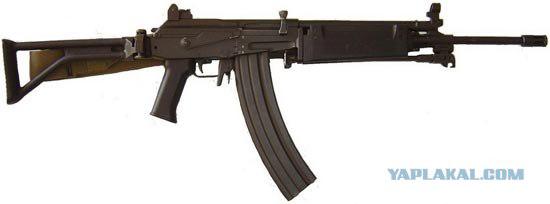
Boar (Ukraine)
In 2003, the Scientific and Technical Center of Precision Engineering of the National Space Agency of Ukraine was presented machine "Boar" ("Wild Boar" - in Russian).
The machine was created as the modernization of the AK-74, and is made on a "bullpup".
"Boar" is positioned as a replacement, the armament of Armed Forces of Ukraine Kalashnikov AKM and AK-74 remaining since Soviet times.
In comparison with the AK-74 machine "Boar" has acquired a number of advantages.
Handle fire control in front of the shop - it is located in the center of gravity of a pistol principle. The main advantage of this solution is that a fighter keeps the machine with one hand.
When firing long bursts, "boar", in contrast to the usual Kalashnikov, no lifts up and right, and vibrates parallel to the line of sight, almost without changing the position of the barrel. Due to a much wider butt plate returns it becomes much softer.
"Boar" adjusted not only by "right-handed", but under "Lefty».
According to various sources, as opposed to the Kalashnikov assault rifle, in the Ukrainian weapons to less than 43 parts.
Moreover, designers failed to double the performance in accuracy (as compared to "AK»).
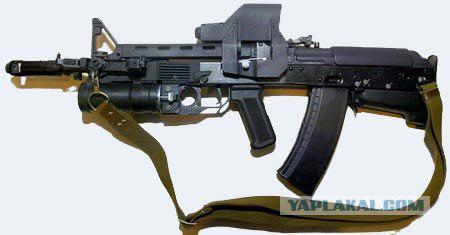
Zastava M21 (Serbia)
In the second half of the twentieth century in Serbia, at that time a member of the Socialist Federal Republic of Yugoslavia, at the state enterprise «Zastava» mastered the production license of the Soviet Kalashnikov AK-47.
By design, in terms of all mechanisms of automatic Zastava M21 is a copy of the Kalashnikov assault rifle with a gas engine automatic, magazine-fed, and air-cooled barrel, with the possibility of single and automatic fire species. Design and operation of all units and mechanisms M21 is identical to the corresponding elements of the AK-47.

KbkS wz 96 (Poland)
Poland was the first country of the former Warsaw Pact, which in 1994 began to take on NATO weapons armed with small sample. This decision was dictated by a desire to speed up the process of integration into NATO, as well as a plan to send troops to the NATO peacekeeping forces in the former Yugoslavia.
Given the extensive network of weapons factories and the experience gained in the production of various modifications of the Soviet Kalashnikov assault rifle, the Polish military leadership decided not to buy foreign-caliber assault rifles 5, 56h45 mm, and upgrade machines, operated by the Polish army under NATO cartridge. Such a decision, in part, was dictated by economic considerations.
As a result, in 1995, work began on the modernization of the Polish automatic rifle Kbk wz. 88 Tantal and shortened machine Skbk wz 89 Onyks caliber 5.45x39 mm NATO cartridge is a standard 5 mm 56h45. The work went quickly enough, as early as 1991 were created a few sample data export machines under the cartridge caliber 5 mm NATO 56h45 - Kbk wz. 90 Tantal (automatic) and Skbk wz 91 Onyks (shortened Machine), respectively.

MINSAS (India)
Automatic MINSAS based on the design of the Kalashnikov assault rifle, and includes a number of elements borrowed from the Soviet machine, however, has a number of significant changes.
Design of pressed steel receiver, locking unit with a rotating bolt, gas operated mechanism are broadly similar to those nodes Kalashnikov.
A little later MINSAS machine has been improved. The new model has been reshaped forend and pistol grip, introduced a new butt skeletal structure, folding side and on the receiver mounted rail-type Picatinny.
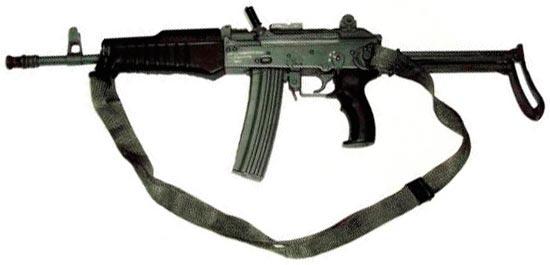
MPi-K (Germany)
In 1961, the German Democratic Republic (GDR) acquired a license for the production of the Soviet Kalashnikov AK-47 series of 7.62x39 mm caliber, the issue of which has been adjusted national enterprise VEB Fahrzeug und Waffenfabrik «Ernst Thalmann» in Suhl.
Structurally Kalashnikov German production of the device and operation of all units and mechanisms are replicas of Soviet counterparts with a gas engine automatic, magazine-fed, and air-cooled barrel, with the possibility of single and automatic fire. The performance characteristics of the German family MPi machines similar to the corresponding models of Soviet arms.
After the reunification of Germany Machines former National People's Army of the GDR family MPi were adopted by the Bundeswehr as a weapon of limited standard.

Source:
After creating in 1955 the Warsaw Treaty Organization (WTO) under the leadership of the Soviet Union, in the framework of the countries - participants, started standardization of weapon systems and ammunition.
Most countries - Soviet satellites came very simply and had adopted the Soviet AK-47 (and later AKM) in a more or less modified form. However, Czechoslovakia, which had historically very strong and advanced armaments jobs, chose to create their own designs of weapons under the overall cartridge.
Auto Sa vz. 58 are of high quality and exterior, as well as the original design. Despite the resemblance to the Soviet AK Czech machine it was fundamentally different, and completely original design. Even the machine shop model 58 was a completely different, although superficially similar to the store Kalashnikov.

LADA / CZ 2000 (Czech Republic)
In 1989, after a series of tests and improvements, the company Ceská Zbrojovka has introduced a family of small arms caliber LADA 5, 45h39 mm.
For reasons of unification of weapons, as well as economy, in contrast to the machine CZ Sa vz. 58 Czechs have decided not to develop the original system, and modify the Soviet system on the basis of Kalashnikov AK-74 at their wishes and preferences.
LADA / CZ 2000 is characterized by high service and performance characteristics, virtually conceding the Soviet AK-74 assault rifles and American M16A2 reliability and performance under different operating conditions.

After the breakup of the Socialist Federal Republic of Yugoslavia (SFRY), armed with an independent Croatia was part until 1991 a part of Yugoslavia, Zastava M70 machine guns were under the Soviet 7.62x39 mm cartridge.
In order to replace the Zastava M70 automatic small arms, ammunition standardized by NATO, Croatian war set the task to develop a new assault rifle (automatic) chambered 5.56h45 mm NATO.
In the early 1990's during the war for independence in Croatia were put South African machines Vektor R4 (licensed copy of the Israeli Galil 5.56 mm caliber), who praised the Croatian military.
Croatians have acquired a license to manufacture the Israeli machine and in 1993 on the basis of Galil developed a new machine under the cartridge 5.56h45 mm, which in 1995 was adopted by the Croatian Army with the designation of APS 95.
APS 95 is a slightly modernized version of the machine of the Israeli Galil, and differs from it only in appearance (have changed shape forend and pistol grip, used new sights), and on the structure and functioning of all units and mechanisms identical to the Israeli sample.

In 1981, the Hungarian People's Army (Magyar Nyphadsereg) to re-start automatic caliber 7.62x39 mm NGM-automatic 81 mm caliber 5.45h39.
GM-81 is a licensed copy of the Soviet AK-74, the production of which has been established by Hungarian Fegyver e Gazkeszulekgyar (FEG) in Budapest in a short time.
By design, in terms of all mechanisms, NGM-81 is a replica of a Kalashnikov AK-74, but the Hungarian engineers made minor changes in their.
From the Soviet model NGM-81 is different, using the wood for the manufacture of the stock, forearm, handguard and pistol grip fire control with a protruding base (a characteristic feature of all Hungarian machines created on the bases of the Soviet model), as well as the presence of reinforced slotted flame arrester, providing increase the accuracy of fire especially when shooting continuous fire.

Developing its own assault rifle in Israel began after the "six-day" Arab-Israeli war (06.05.1967 city - 06/10/1967 city).
The project was the construction of the Finnish Galili machine Valmet RK.62 (which, in turn, is a licensed version of AK-47) license which was acquired from the Finns. The system of automation and locking the barrel, the design of the bolt, bolt and trigger mechanism were borrowed from the Kalashnikov assault rifle; the design of the barrel, bolt cups, shop - have experienced the American system of Stoner-63; receiver, magazine catch and sights - the Finnish Valmet RK.62; a folding butt - from the Belgian FN FAL Para; compensator device arrester - the American M16A1 Colt. Also I. Galili and added several new features of its own.
As a result, in 1973 it adopted the Israeli army was adopted rifle design Yisrael Galili, developed at the state armory enterprise Israel Military Industries (IMI). The rifle was designated «Galil» and launched into production. To issue assault rifle (automatic) Galil in Finland were purchased manufacturing equipment and documentation.

KL-7.62 (Iran)
During the Iran-Iraq war of 1980-1988 for arming the Iranian Army Iranian government has been established in the purchase of large quantities of Chinese machines Type 56 (a copy of the Soviet Kalashnikov AK).
Later conglomerate Iranian Defense Industries Organization (DIO) was established its own production machines under the designation Type 56 KL-7.62.
Machine KL-7.62 is an unlicensed version of the Type 56 (Kalashnikov) and the original version was indistinguishable from its prototype, but later was upgraded through the use of plastics instead of wood, with a slightly altered weight and dimensions.
By design KL-7.62 as well as the Type 56 is a copy of the Soviet Kalashnikov AK.

PA md 63 (Romania)
In the 1970s, under the member countries of the Warsaw Pact were standardized arms and ammunition under the new caliber 5.45h39 mm. In this connection, the Soviet Union offered its new satellites a Kalashnikov AK-74.
However, Romania refused to purchase a license for the production of AK-74 and decided independently adapted to the caliber 5.45h39 mm, are armed with their own machines PM md 63 and PM md 65 caliber 7.62x39 mm, is an exact copy of the license of the Soviet AKM with minor changes. < br /> As a result, in the second half of the 1980s adopted in Romania it was adopted, developed by RomArm, the new automatic caliber 5.45h39 mm - PA md 86 (Puşcă Automată model 1986 - automatic rifle model 1986) in two versions - fixed and folding stock .
on the structure and functioning of all components and mechanisms is an exact copy of the Soviet AKM with a gas engine automatic, magazine-fed, and air-cooled barrel, with the possibility of single and automatic fire.

Working on a new project firearm infantry China to replace aging machines Type 56 (licensed copy of the Kalashnikov AK sample 1947) and Type 68 was launched in the early 1970s.
As a result, in 1981 adopted the National Liberation Army (PLA) adopted a new family of weapons under the designation Type 81 caliber 7.62x39 mm, consisting of two assault rifles Type 81 and Type 81-1 and machine gun Type 81.
Automatic (assault rifle) Type 81 machine is a further development of the Chinese develop Type 56 and Type 68, but with significant changes in design, as well as to reduce recoil and increase accuracy. Visually machines Type 81 is easily distinguished from Kalashnikov assault rifles on the longer barrel and large gaps between the trigger guard and a shop.
The first machines Type 81 was used by the PLA during the border conflict with Vietnam in the mid-1980s, which proved to be a reliable weapon, a little superior to Kalashnikov assault rifles on the effective range (due to the longer barrel with a similar cartridge) and comfort (by some lower perceived recoil).
In addition to the PLA machines and machine guns Type 81 were supplied into service in Algeria, Bangladesh, Burma, Nepal, Pakistan, Sudan, Sri Lanka.

In 1986, the Finnish company Valmet, which created a whole family of firearms (machine guns, machine gun, sniper rifle) on the basis of the Soviet Kalashnikov AK, work began on the development of an improved version of the machine.
In 1987, the company Sako (also engaged in the production of weapons) and Valmet merged to form the concern Sako-Valmet. After several passages of a controlling stake from one person to another name Sako got owned by a private equity company, will continue to produce small arms and ammunition. As a result, a new machine has been developed under the brand name Sako.
In 1990 Sako proposed model of the new machine under the designation Rk 90 (Ryannakkokivaari 90 - Assault rifle model 1990), also known as M-90.
The automatic M-90, based on the design of the machine Valmet Rk 62 (which is by design, in terms of all mechanisms, is a replica of the Kalashnikov assault rifle) with milled receiver, got collapsible side butt, made according to the type of Israeli machine Galil, made up of two tough steel tubes.

Vektor R4 (South Africa)
At the end of the 1970s, the South African National Self-Defense Force (SANDF - South African National Defence Force), it was decided to replace, in service with the South African Belgian FN FAL rifles and German HK G3 7.62 mm on the new weapon caliber 5.56 mm.
As a result, the South African company Vektor (a division of military-industrial concern DENEL - the main supplier of arms to South Africa) was designed assault rifle chambered for 5.56x45 mm NATO, which received the designation R4.
At the same time to save time and money, the new South African Vektor R4 rifle did not create from scratch, but already used positively proven automatic Israeli Galil, upgrade it. Himself automatic Galil is based on the Finnish Valmet Rk 62 rifles, which in turn is a modernized version of the Soviet AK-47.

Boar (Ukraine)
In 2003, the Scientific and Technical Center of Precision Engineering of the National Space Agency of Ukraine was presented machine "Boar" ("Wild Boar" - in Russian).
The machine was created as the modernization of the AK-74, and is made on a "bullpup".
"Boar" is positioned as a replacement, the armament of Armed Forces of Ukraine Kalashnikov AKM and AK-74 remaining since Soviet times.
In comparison with the AK-74 machine "Boar" has acquired a number of advantages.
Handle fire control in front of the shop - it is located in the center of gravity of a pistol principle. The main advantage of this solution is that a fighter keeps the machine with one hand.
When firing long bursts, "boar", in contrast to the usual Kalashnikov, no lifts up and right, and vibrates parallel to the line of sight, almost without changing the position of the barrel. Due to a much wider butt plate returns it becomes much softer.
"Boar" adjusted not only by "right-handed", but under "Lefty».
According to various sources, as opposed to the Kalashnikov assault rifle, in the Ukrainian weapons to less than 43 parts.
Moreover, designers failed to double the performance in accuracy (as compared to "AK»).

Zastava M21 (Serbia)
In the second half of the twentieth century in Serbia, at that time a member of the Socialist Federal Republic of Yugoslavia, at the state enterprise «Zastava» mastered the production license of the Soviet Kalashnikov AK-47.
By design, in terms of all mechanisms of automatic Zastava M21 is a copy of the Kalashnikov assault rifle with a gas engine automatic, magazine-fed, and air-cooled barrel, with the possibility of single and automatic fire species. Design and operation of all units and mechanisms M21 is identical to the corresponding elements of the AK-47.

KbkS wz 96 (Poland)
Poland was the first country of the former Warsaw Pact, which in 1994 began to take on NATO weapons armed with small sample. This decision was dictated by a desire to speed up the process of integration into NATO, as well as a plan to send troops to the NATO peacekeeping forces in the former Yugoslavia.
Given the extensive network of weapons factories and the experience gained in the production of various modifications of the Soviet Kalashnikov assault rifle, the Polish military leadership decided not to buy foreign-caliber assault rifles 5, 56h45 mm, and upgrade machines, operated by the Polish army under NATO cartridge. Such a decision, in part, was dictated by economic considerations.
As a result, in 1995, work began on the modernization of the Polish automatic rifle Kbk wz. 88 Tantal and shortened machine Skbk wz 89 Onyks caliber 5.45x39 mm NATO cartridge is a standard 5 mm 56h45. The work went quickly enough, as early as 1991 were created a few sample data export machines under the cartridge caliber 5 mm NATO 56h45 - Kbk wz. 90 Tantal (automatic) and Skbk wz 91 Onyks (shortened Machine), respectively.

MINSAS (India)
Automatic MINSAS based on the design of the Kalashnikov assault rifle, and includes a number of elements borrowed from the Soviet machine, however, has a number of significant changes.
Design of pressed steel receiver, locking unit with a rotating bolt, gas operated mechanism are broadly similar to those nodes Kalashnikov.
A little later MINSAS machine has been improved. The new model has been reshaped forend and pistol grip, introduced a new butt skeletal structure, folding side and on the receiver mounted rail-type Picatinny.

MPi-K (Germany)
In 1961, the German Democratic Republic (GDR) acquired a license for the production of the Soviet Kalashnikov AK-47 series of 7.62x39 mm caliber, the issue of which has been adjusted national enterprise VEB Fahrzeug und Waffenfabrik «Ernst Thalmann» in Suhl.
Structurally Kalashnikov German production of the device and operation of all units and mechanisms are replicas of Soviet counterparts with a gas engine automatic, magazine-fed, and air-cooled barrel, with the possibility of single and automatic fire. The performance characteristics of the German family MPi machines similar to the corresponding models of Soviet arms.
After the reunification of Germany Machines former National People's Army of the GDR family MPi were adopted by the Bundeswehr as a weapon of limited standard.

Source:
